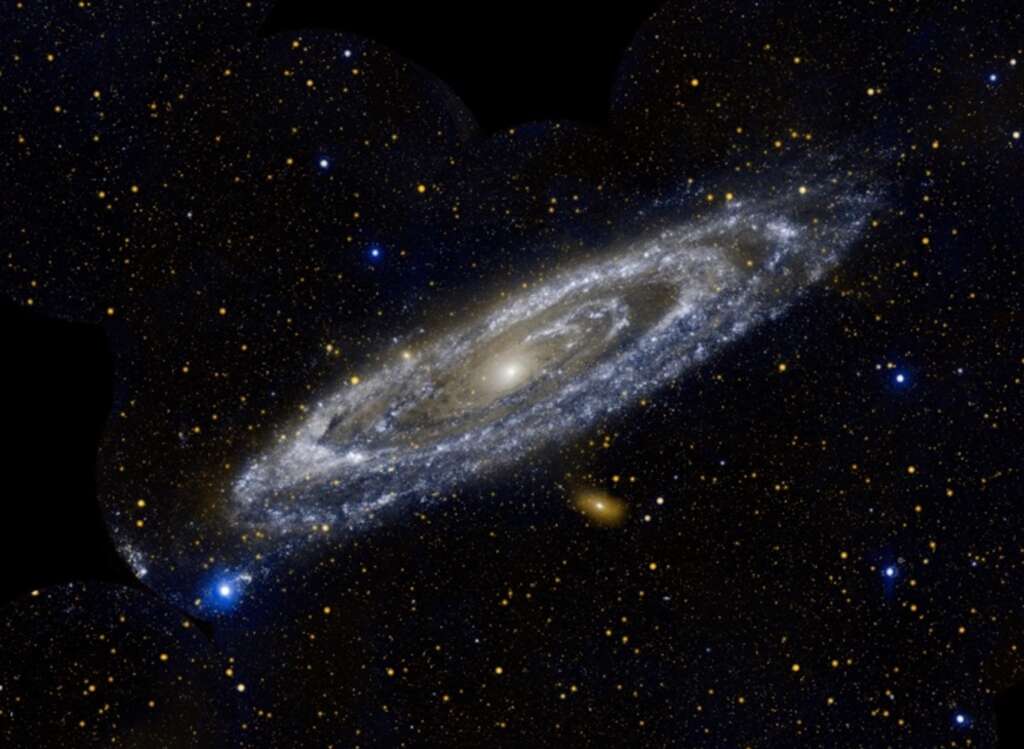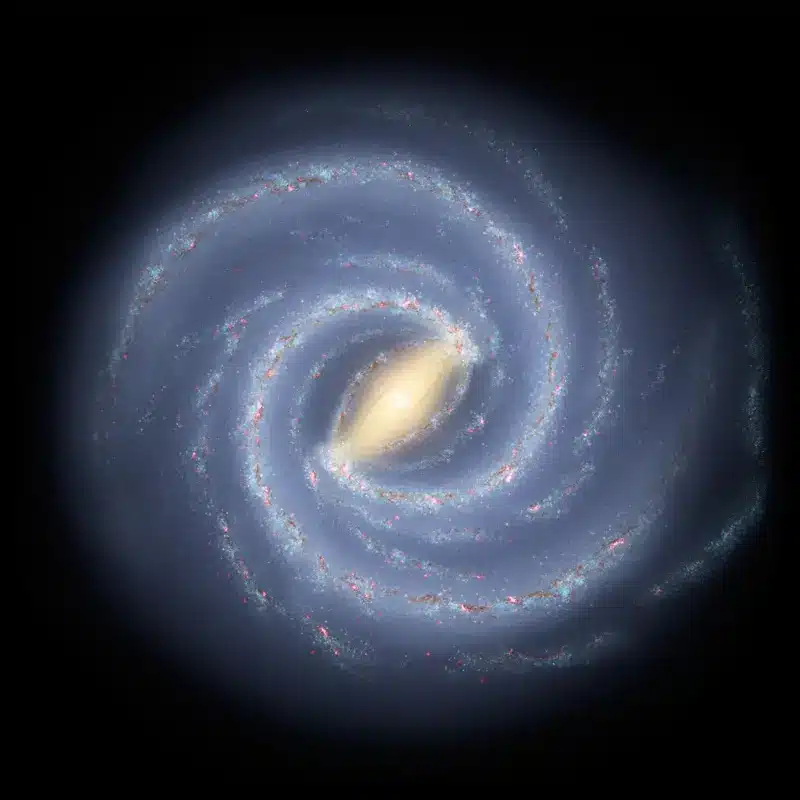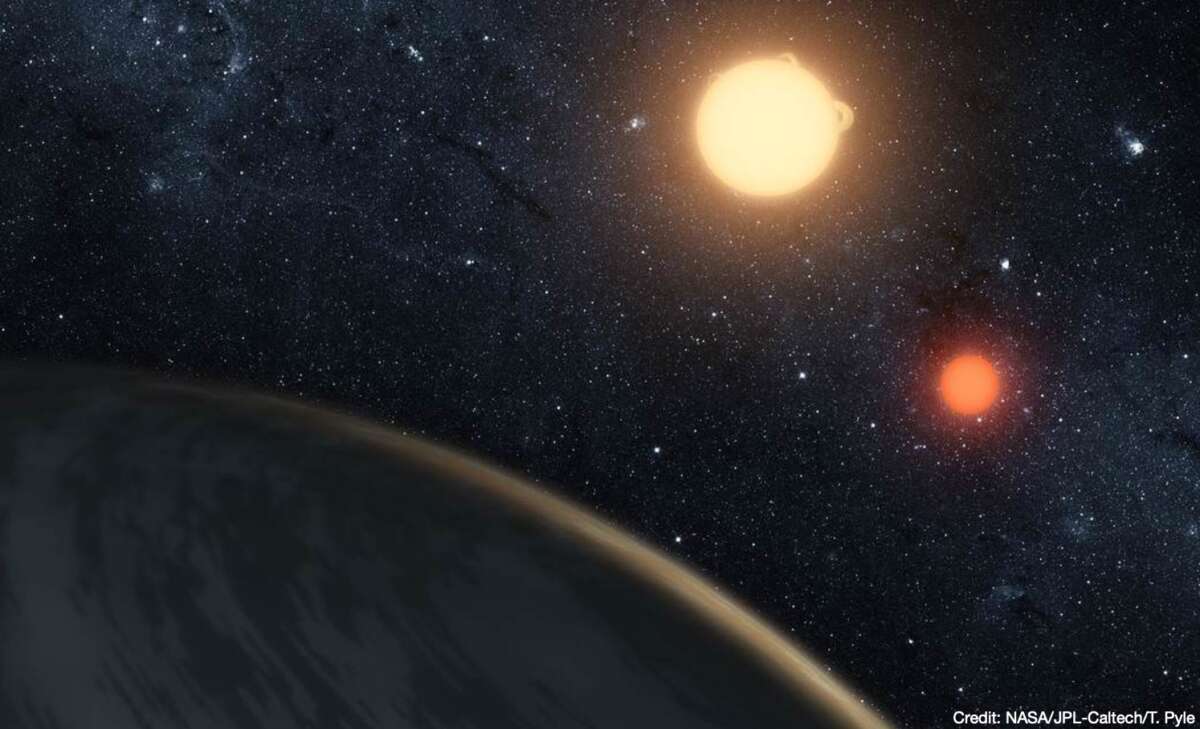A word about galaxies before I get into Kepler 16. Our galaxy is called the Milky Way. There is no technical designation for it because no one discovered it. It was always there. It is classified as a barred spiral galaxy, which suggests that it is a very mature galaxy. This is because it takes billions of years for the barrel-like “bar” to appear in the center of the core of the galaxy (see the second illustration beneath to see what a bar looks like.) Younger galaxies do not have “bars.” Barred spirals would look like a spinning pinwheel if seen from a different perspective. As an example, see the Andromeda galaxy iimmediately below. However, the “spin” of our galaxy takes hundreds of millions of years for a complete rotation (225-250 million years for our sun which is halfway from the outer edge to the core. Much, much longer for the stars on the edge.) Our Sun is located on one of the spiral arms, about 25,000 light-years away from the center of the galaxy. A fairly familiar and similar barred spiral galaxy is the Andromeda galaxy (M32) in the constellation Andromeda (see below.) Our galaxy moves through space at 372 miles per second.

For those of you who have just a casual acquaintance with astronomy, let me back up a step for the sake of orientation and context.
We are on one of eight planets in our Solar System (Pluto is no longer considered a planet by definition.) Our solar system is one of many in what is called the Local Group. The Local Group is the name given to those stars and other galaxies that are in close proximity (as “close” is considered to be in space) to Earth. In some sense, the Local Group is our immediate neighborhood in space. A better explanation for this comes from Earth/Sky:
“The Local Group galaxies are all located within roughly 5 million light-years of space around us. The Local Group’s diameter as a whole is about 10 million light-years. Our Milky Way is just one of three large galaxies in the Local Group. But it’s not the biggest of the Local Group galaxies. That would be the Andromeda galaxy. And the third galaxy, called the Triangulum galaxy, is the smallest of the three large ones. There are also 50 or so dwarf galaxies in the Local Group.”
The next level if we zoom out would be the universe, itself, with greater than 100 billion galaxies (including ours.) It was once thought and taught–even in my lifetime–that the universe was all that there was. But today, some theorists consider that there may very well be other universes (and the term for this is “multiverse”) seeming to “float” in space like soap bubbles in the air. Each might have physical laws and properties much different than our own universe.
The stars of Kepler 16

The two stars in the Kepler 16 system, located in the constellation Cygnus the swan, some 200 light years from Earth are home to what’s called a circumbinary planet, meaning “it orbits both stars simultaneously. The two stars are similar to our Sun, though [of] lower mass, smaller in size and cooler. One star, called Kepler 16a, is a K-type, about 0.65 times the Sun’s mass and about 1/7th the Sun’s brightness.” K-type stars are sometimes called orange dwarfs. An example of a K-type star is Arcturus, in this case a red giant and not a dwarf at all in the constellation Boötes. K-type stars are of particular interest in the search for extra-terrestrial life, since they emit markedly less Ultra Violet radiation (which damages or destroys DNA1) than other types of stars. This k-type star is the primary of the two in this system. The other star in this system is an M type star similar to Wolf 359. The two stars of Kepler 16 “orbit each other at a distance of about 33 million kilometers, taking 41 days to do so.”
Some interesting details:
- Altogether, 75% of the stars in our galaxy are red dwarfs.
- Around 85% of the stars in our galaxy are at least binary with three or more stars occasionally in the star system.
- Most single stars have multiple exoplanets.
- Only a third of binary stars have exoplanets.
The announcement that the Kepler system had a planet was made in 2011. The word was:
“Kepler-16b is an inhospitable, cold world about the size of Saturn and thought to be made up of about half rock [and ice] and half gas.“
“[The] Kepler mission has made the first unambiguous detection of a circumbinary planet — a planet orbiting two stars — 200 light-years from Earth.”
Unlike Star Wars’ Tatooine, the planet is cold, gaseous and not thought to harbor life, but its discovery demonstrates the diversity of planets in our galaxy. Previous research has hinted at the existence of circumbinary planets, but clear confirmation proved elusive. Kepler detected such a planet, known as Kepler-16b, by observing transits, where the brightness of a parent star dims from the planet crossing in front of it.“

Technically, the planet that circles these two stars is not in the habitable zone which means that liquid water is not present.2 The importance of water to life is discussed in this post.
NASA noted that the planet (Kepler 16b) could not be directly observed, but based on other tests they could note with certainty that
“This discovery confirms that Kepler-16b is an inhospitable, cold world about the size of Saturn and thought to be made up of about half rock [and ice] and half gas. The parent stars are smaller than our sun. One is 69 percent the mass of the sun and the other only 20 percent. Kepler-16b orbits around both stars every 229 days, similar to Venus’ 225-day orbit, but lies outside2 the system’s habitable zone, where liquid water could exist on the surface, because the stars are cooler than our sun.“
There has been some modeling and speculation that a yet-to-be-discovered moon circles Kepler B, but that is purely hypothetical.
The Kepler Space Telescope ran out of fuel in 2018 and was sent its last command (“Goodnight”) on November 15, 2018, the 388th anniversary of its namesake Johannes Kepler’s birthday. It continues to orbit harmlessly in space.
Feature photo caption
This artist’s concept illustrates Kepler-16b, the first planet known to definitively orbit two stars – what’s called a circumbinary planet. The planet, which can be seen in the foreground, was discovered by NASA’s Kepler mission.
The two orbiting stars regularly eclipse each other, as seen from our point of view on Earth. The planet also eclipses, or transits, each star, and Kepler data from these planetary transits allowed the size, density and mass of the planet to be extremely well determined. The fact that the orbits of the stars and the planet align within a degree of each other indicate that the planet formed within the same circumbinary disk that the stars formed within, rather than being captured later by the two stars.
Footnotes
1The problems UV radiation causes to DNA involve copying errors when the DNA replicates itself. Most of use are familiar with the effects of UV radiation if we’ve ever had a bad sunburn.
2Some sources claim it is just inside the outer edge of the habitable zone. Surface temperatures are estimated to be −150 to −94 °F which is generally uninhabitable for life, though the East Antarctica Plateau on Earth has temperatures that come close to this.




